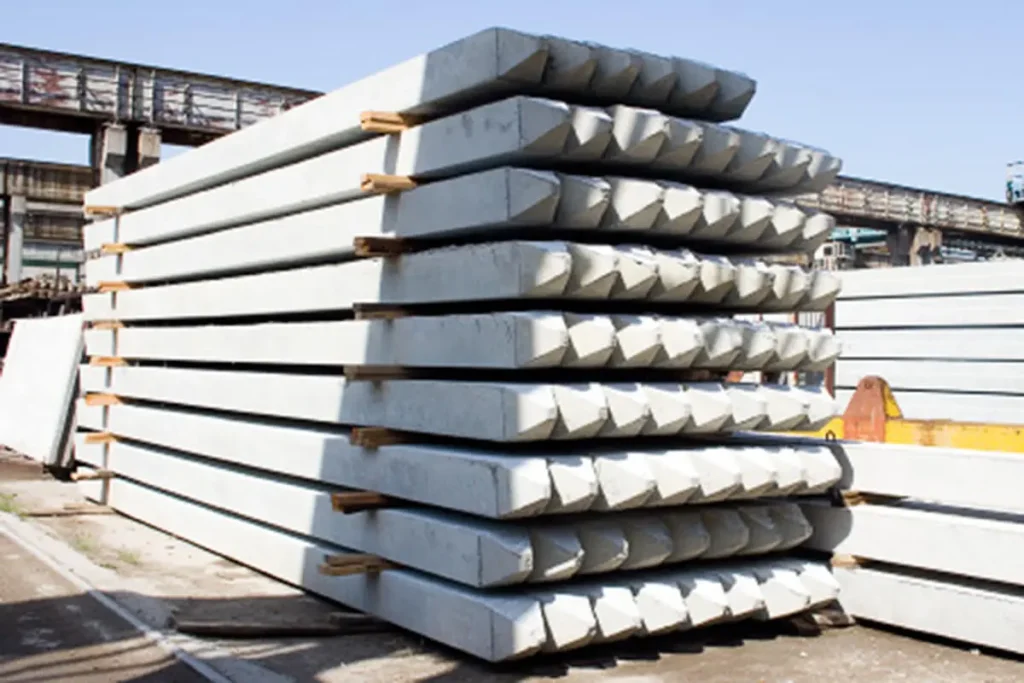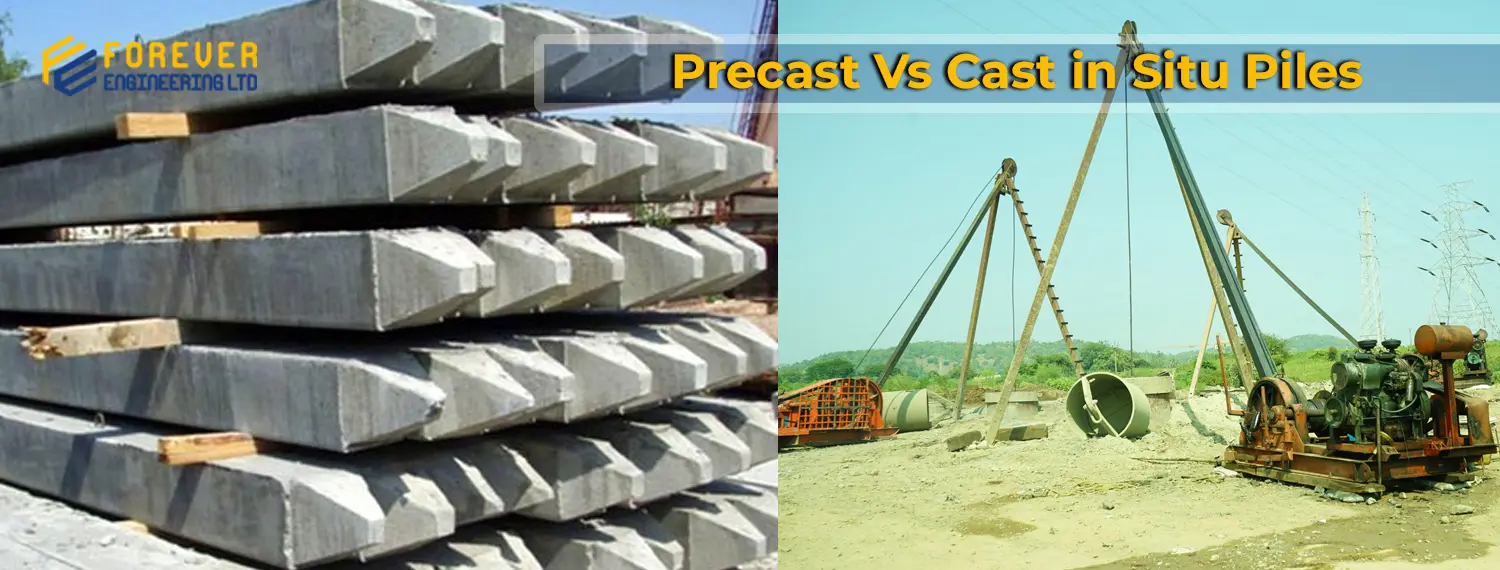Nowadays, the construction industry is growing with new technologies. Researchers and national associations hold various research and development programs to find economic and time-saving technologies for construction. Precast concrete and cast in situ piles are one of them. Today, we are going to expose the Difference Between Precast and Cast in Situ Piles. So, let’s get started on them and learn how Forever Engineering helps you in the precast concrete pile construction industry.
At the very beginning let’s learn something about precast pile and cast in situ concrete pile.
What is Precast Pile?
Table of Contents
Toggle
Precast piles are the most well-known and widely used foundation method worldwide. Compared to wooden piles, they are usually the quickest and cheapest.
Precast concrete piles have high resistance. Their main benefit is a high vertical pile load. The allowable capacities for concrete piles on a design-build basis range from 125 to over 750 kips per pile.
They are reinforced concrete piles that come in different shapes. They could be circular, rectangular, square, or octagonal.
What is Cast in situ Pile?

Cast in situ refers to casting that is done on the actual site. Everything is assembled and cast on the spot; no prior casting is done. Cast in situ piles are formed after a steel shell made of spirally wound hard-drawn wire is driven into the ground. After reaching the desired depth, the concrete is poured into it and allowed to harden.
Difference Between Precast and Cast in Situ Piles
1. Definition
Precast Pile
- Precast concrete, which can be plant-cast or site-cast, is cast into a specific shape in a location other than a construction site, such as a factory. The concrete is then placed into a form, usually made of wood or steel, and cured before being transported to the construction site for erection.
Cast in Situ Pile
- Cast-in-place concrete is poured into forms on the construction site. It provides the designer with unlimited possibilities for any shape format and an infinite variety of surface textures.
2. Casting
Precast Pile
- Precast concrete components are produced in a controlled casting facility. This makes it easier to control the mix, placement, and curing. Time is saved because elements can be cast ahead of time and kept until the hour you need them. The weather has no impact on casting work.
Cast-in-situ Pile
- Cast-in-situ concrete, columns, slabs, and other elements are cast on-site in the open environment, making it difficult to control mixture, placement, and curing. You cannot cast the elements ahead of time. The weather may delay the casting process.
3. Quality Control
Precast Pile
- Controlling and maintaining the precast pile’s quality is simple.
Cast in situ Pile
- Controlling and maintaining the cast in situ pile quality is difficult.
4. Cost
Precast Pile
- Precast concrete is a less expensive building material if big structures need to be built. However, maintenance costs for precast concrete structures are higher.
Cast in situ Pile
- For small structures, in situ concrete is a cost-effective construction method. When compared to precast concrete structures, cast-in-situ concrete structures require less maintenance.
5. Requirement of Worker & Machinery
Precast Pile
- It requires fewer workers to complete. On building sites, skilled workers are needed. A knowledgeable and experienced contractor is needed to construct the precast concrete structure. Precast concrete requires large machinery and cranes for handling, that is, lifting and installing heavy elements.
Cast in situ Pile
- It requires more laborers. Skilled laborers are necessary on construction sites. Local contractors can also construct the structure. Cast-in-place concrete does not require this type of handling equipment.
6. Strength
Precast Pile
- Precast concrete construction is quick because it can be installed right away and does not require time to harden. Accelerated curing can lead to an increase in strength. On-site strength testing is not required. High-strength concrete can be used because it is under controlled conditions.
Cast in situ Pile
- Concrete is slowly in situ because it takes time to become stronger in situ. Accelerated curing makes increasing aging more difficult. You need to do a site strength test. Depending on the site and resources, using high-strength concrete will be challenging.
7. Time of Construction
Precast Pile
- It takes less time to construct overall than cast-in-situ. It is possible to construct quickly.
Cast in situ Pile
- The total construction time is longer than that of the precast. Speed is less as elements are cast at the site.
8. Technical Points
Precast Pile
- The structural system has a lot of joints. It is not advisable to place less resistance to wind and seismic forces in areas where seismic loads predominate. When building with precast concrete, the details at the joints become crucial and require close attention. The components must be made to withstand loads or stresses during handling, which may or may not increase steel. It is possible to create elements with different shapes and lengths. There is no monolithic architectural character to precast concrete.
Cast in situ Pile
- More resistant to earthquakes and winds. Elements cannot be cast in advance. Elements should not be designed to withstand such loads or stresses. An element’s length and shape are both constrained. A monolithic architectural character can be obtained with in situ concrete.
9. Surface Finishing
Precast Pile
- Because precast concrete has a smooth interior finish, less preparation is needed before painting, applying wallpaper, or applying other wall coverings.
Cast in situ Pile
- Plastering is necessary for a smooth finish in cast-in-situ concrete construction, and it also needs to be done in advance for paint applications such as wall putty.
10. Important Things to Remember
Precast Pile
- Precast concrete requires careful handling during construction because handling and transportation can cause damage to the unit.
Cast in situ Pile
- In cast-in-situ concrete construction, be careful about the following points:
- During the concreting process, things like mixing, transportation, placing, finishing, etc.
- Curing of concrete for a certain time, etc.
To summarize, the primary distinction between precast and in-situ concrete is the location of the casting and curing processes. Precast concrete components are cast off-site and transported for installation, whereas in-situ concrete is poured and cured on-site, potentially resulting in longer curing times.
This method provides faster construction times and controlled quality, but design modifications are not as flexible. The decision between the two approaches frequently comes down to the particular needs of the project, as each has pros and cons of its own.
Why Forever Engineering for Pile Driving in Bangladesh
As the pioneer in the pile driven and cast in situ piles sector, Forever Engineering Ltd. is dedicated to offering the shop and field equipment that utilizes the most advanced, dependable, and safe technologies available in pile driving today. We think that our Piles Driving services result in projects of the highest caliber, and we have an unmatched performance history, dependable communications, open management, and customer trust.
Get in touch with us right now to begin serving your precast pile in Bangladesh needs with Forever Engineering Ltd. It is our pleasure at Forever Engineering Ltd. to be accessible to assist our clients day or night. Our commitment to superior service and client satisfaction is unparalleled in the industry.
Final Words
Finally, you have learned the difference between precast and cast in situ piles. Precast and cast-in-situ concrete piles both offer a sturdy and dependable foundation, and the choice between the two is frequently based on the needs of the project and the preferences of the client. Get in touch with a team member right now for all of your piling needs!

